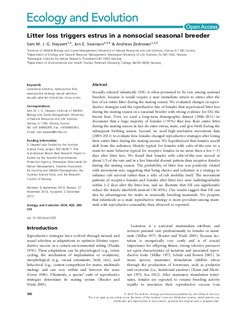| dc.contributor.author | Steyaert, Sam | |
| dc.contributor.author | Swenson, Jon | |
| dc.contributor.author | Zedrosser, Andreas | |
| dc.date.accessioned | 2018-06-18T11:31:41Z | |
| dc.date.available | 2018-06-18T11:31:41Z | |
| dc.date.created | 2014-01-08T14:32:05Z | |
| dc.date.issued | 2014 | |
| dc.identifier.citation | Ecology and Evolution. 2014, 4 (3), 300-310. | nb_NO |
| dc.identifier.issn | 2045-7758 | |
| dc.identifier.uri | http://hdl.handle.net/11250/2501892 | |
| dc.description.abstract | Sexually selected infanticide (SSI) is often presumed to be rare among seasonal breeders, because it would require a near immediate return to estrus after the loss of an entire litter during the mating season. We evaluated changes in reproductive strategies and the reproductive fate of females that experienced litter loss during the mating season in a seasonal breeder with strong evidence for SSI, the brown bear. First, we used a long-term demographic dataset (1986–2011) to document that a large majority of females (>91%) that lose their entire litter during the mating season in fact do enter estrus, mate, and give birth during the subsequent birthing season. Second, we used high-resolution movement data (2005–2011) to evaluate how females changed reproductive strategies after losing their entire litter during the mating season. We hypothesized that females would shift from the sedentary lifestyle typical for females with cubs-of-the-year to a roam-to-mate behavior typical for receptive females in no more than a few (~3) days after litter loss. We found that females with cubs-of-the-year moved at about 1/3 of the rate and in a less bimodal diurnal pattern than receptive females during the mating season. The probability of litter loss was positively related with movement rate, suggesting that being elusive and sedentary is a strategy to enhance cub survival rather than a relic of cub mobility itself. The movement patterns of receptive females and females after litter loss were indistinguishable within 1–2 days after the litter loss, and we illustrate that SSI can significantly reduce the female interbirth interval (50–85%). Our results suggest that SSI can also be advantageous for males in seasonally breeding mammals. We propose that infanticide as a male reproductive strategy is more prevalent among mammals with reproductive seasonality than observed or reported. Lactational anestrus, reproductive fate, reproductive strategy, sexual selection, sexually selected infanticide, Ursus arctos. | nb_NO |
| dc.language.iso | eng | nb_NO |
| dc.rights | Navngivelse 3.0 Internasjonal | * |
| dc.rights | Navngivelse 3.0 Internasjonal | * |
| dc.rights.uri | http://creativecommons.org/licenses/by/3.0/deed.no | * |
| dc.title | Litter loss triggers estrus in a nonsocial seasonal breeder | nb_NO |
| dc.type | Journal article | nb_NO |
| dc.type | Peer reviewed | nb_NO |
| dc.description.version | publishedVersion | nb_NO |
| dc.rights.holder | 2014, The Authors. | nb_NO |
| dc.source.pagenumber | 300-310 | nb_NO |
| dc.source.volume | 4 | nb_NO |
| dc.source.journal | Ecology and Evolution | nb_NO |
| dc.source.issue | 3 | nb_NO |
| dc.identifier.doi | 10.1002/ece3.935 | |
| dc.identifier.cristin | 1085922 | |
| cristin.unitcode | 222,58,1,0 | |
| cristin.unitname | Institutt for natur, helse og miljø | |
| cristin.ispublished | true | |
| cristin.fulltext | original | |
| cristin.qualitycode | 1 | |

